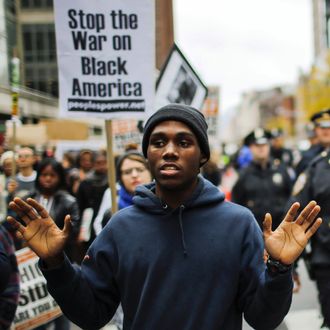
Roughly 44 million Americans have an encounter with police each year. During these routine stops, in cars or on the street, black Americans are twice as likely as white Americans to experience excessive force at the hands of police. The data, composed of public surveys collected and compiled by the Department of Justice, reveals that 75 percent of those stopped by police reported excessive force of some kind. Respondents defined excessive force broadly, ranging from verbal aggression (shouting, cursing, threatening) to physical force (grabbing, punching, kicking) and include severe responses (pepper spray, Taser usage, or officers pulling their guns out).
The report collected responses over the course of ten years, from 20o2 to 2011.
Every three years, the department’s Bureau of Justice Statistics conducts a Police-Public Contact Survey. Respondents were not prompted with examples of what is considered to be nonfatal force. “Survey respondents defined what they considered to be the threat or use of force and whether it was excessive according to their perceptions of police behavior,” wrote the report’s authors. “Use of force and excessive were not defined for respondents.” In the report — the only of its kind on nonfatal police behavior — black people were more likely to report nonfatal force as excessive, despite encountering police far less frequently than white people.
An increased likelihood of excessive force stemmed more frequently from street stops — a category of interaction with law enforcement that includes “stop-and-frisk” — than from traffic stops. A majority of all police contact occurs in face-to-face proximity on the street. During such stops, black people more frequently reported excessive force than white and Hispanic people as well. Bodily searches were conducted on black people at a higher rate than white people.
In New York City, the stop-and-frisk program, which peaked in 2011 with 685,724 reported stops, would have been a leading driver of excessive-force experiences for minorities, as black people, and other ethnic minority groups, were the most prominent targets of the program.
Criticism of the excessive use of force by police has been a considerable topic of discussion in 2015, from September’s James Blake incident in Manhattan to the one in a South Carolina classroom. Other reports, like this investigation conducted by The Guardian, reveal that black people are killed at twice the rate of white people by police, despite white people being twice as likely to be armed.





























